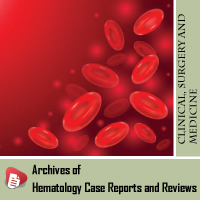Archives of Hematology Case Reports and Reviews
Case Report: NK/T-cell Lymphoma with CMV and EBV Co-infection
Harjap Singh* and Jasjit Singh
Department of Clinical Hematology, Sir Ganga Ram Hospital, New Delhi, India
Cite this as
Singh H, Singh J. Case Report: NK/T-cell Lymphoma with CMV and EBV Co-infection. Arch Hematol Case Rep Rev. 2025;10(1):011-012. Available from: 10.17352/ahcrr.000050Copyright License
© 2025 Singh H, et al. This is an open-access article distributed under the terms of the Creative Commons Attribution License, which permits unrestricted use, distribution, and reproduction in any medium, provided the original author and source are credited.Natural Killer (NK)/T-cell lymphoma is a rare but aggressive subtype of non-Hodgkin lymphoma, frequently associated with Epstein-Barr virus (EBV) and often complicated by rapid clinical deterioration. We present a diagnostically challenging case of a 36-year-old male with fulminant NK/T-cell lymphoma complicated by CMV and EBV co-infection, hepatic dysfunction, and suspected HLH. Despite multidisciplinary management, the patient succumbed due to rapid disease progression before full diagnostic confirmation and initiation of definitive therapy.
Introduction
Extranodal NK/T-cell lymphoma is a rare hematologic malignancy with an aggressive clinical course. Its association with EBV is well documented, while co-infection with CMV is less common and contributes to immune dysregulation. Early diagnosis is essential, yet often delayed due to nonspecific presentation and systemic involvement mimicking infections like tuberculosis or HLH.
ENKTL is much more common in East Asia and, to a lesser extent, in Central and South America. For example, it accounts for 5% - 15% of all lymphomas in Asia, but less than 1% in Western countries such as the United States and Europe.
While the strong association between EBV and NK/TCL is well-established, the specific role of CMV coinfection in the development or progression of NK/TCL is still under investigation. However, given the immunomodulatory effects of both viruses, their co-presence could create a more favorable environment for lymphoma development, especially in the context of immune suppression. Further research is necessary to fully elucidate the complex interactions and their implications for diagnosis, treatment, and prognosis.
Case presentation
A 36-year-old married male, with no comorbidities or history of substance use, presented on 22 May 2025 with progressive abdominal fullness, dyspnea, and low-grade fever. Initial evaluation revealed anasarca, massive ascites, pleural effusion, and pedal edema. Imaging showed generalized lymphadenopathy. PET-CT scan revealed FDG-avid lymphadenopathy (SUV max 24.5). In the context of potential NK/T-cell lymphoma, this suggests a high degree of metabolic activity within the lymph nodes, which is consistent with the characteristics of this type of lymphoma.
Bone marrow aspiration was normocellular. Biopsy was awaited. The patient had hepatosplenomegaly, thrombocytopenia (40*109), transaminitis (SGOT/SGPT 600/900U), hyperbilirubinemia (9 mg/dl), and rash. He deteriorated over the next 10 days and was admitted to the ICU.
Modified R-CHOP was empirically initiated, excluding hepatotoxic agents. Steroids, IVIG, antimicrobials, and anidulafungin were added. Despite this, his condition worsened. CMV and EBV positivity was confirmed late, followed by NK/T-cell lymphoma diagnosis via immunohistochemical staining for specific markers like CD3ε, CD56, and cytotoxic molecules, along with the detection of EBV by EBER, helping in confirming the NK/T-cell lineage of lymphoma, with Ki-67 >80%. GEMOX was considered but not given.
Despite valganciclovir and plasmapheresis for suspected TTP, he succumbed on 22 June 2025, over 4 weeks.
Discussion
This case highlights the aggressive nature of NK/T-cell lymphoma, diagnostic delay due to overlapping infectious symptoms, and the critical role of early IHC. CMV and EBV co-infection likely exacerbated immune dysregulation. Early suspicion and coordinated care are essential. Delayed diagnosis in aggressive lymphomas can lead to missed therapeutic windows and high mortality.
Conclusion
NK/T-cell lymphoma should be considered in rapidly progressive febrile illnesses with systemic features.
Early biopsy, viral studies, and prompt therapy are vital. Delays in diagnosis and a lack of interdepartmental consensus in critical illness can be fatal.
In summary, infections can play a complex role in lymphoma, both as potential causative agents and as significant complications in individuals affected by the disease. Understanding these relationships is crucial for effective prevention, diagnosis, and management strategies
Learning points
- Consider NK/T-cell lymphoma in febrile illness with hepatosplenomegaly and cytopenias.
- Screen for EBV and CMV early in suspected lymphomas.
- Expedite tissue diagnosis and immunophenotyping.
- Foster interdepartmental coordination.
- Use PLEX judiciously, only in confirmed HLH or TTP

Article Alerts
Subscribe to our articles alerts and stay tuned.
 This work is licensed under a Creative Commons Attribution 4.0 International License.
This work is licensed under a Creative Commons Attribution 4.0 International License.

 Save to Mendeley
Save to Mendeley
